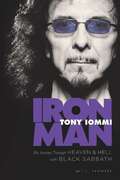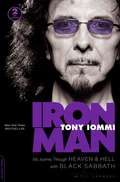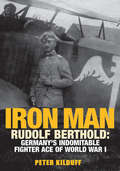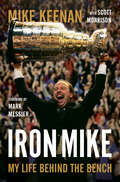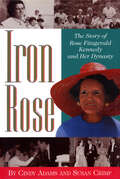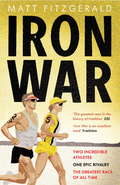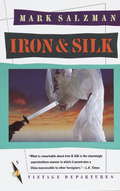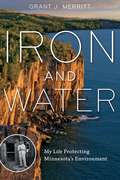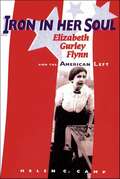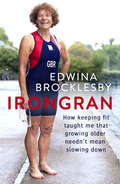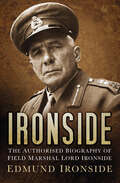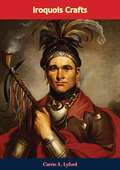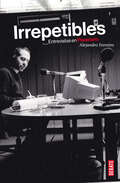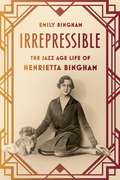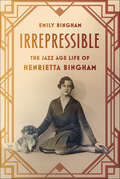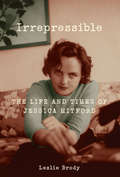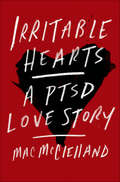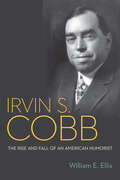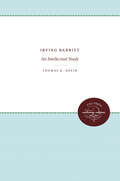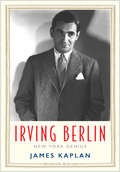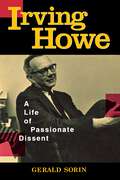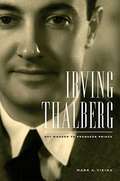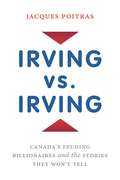- Table View
- List View
Iron Man
by Tony IommiThe memoir of one of the great musicians of our time, Tony Iommi?Grammy-winning revolutionary guitarist, cofounding member of Black Sabbath, and architect of heavy metal
Iron Man: My Journey through Heaven and Hell with Black Sabbath
by Tony IommiTony Iommi, rock guitarist and Black Sabbath legend, invented the heavy metal sound that changed rock music forever . . . from working class Midlands roots, Tony Iommi's unique playing style - a result of a disfiguring hand injury he suffered working in a sheet metal factory - created a dark and gothic sound unlike anything that had been heard before, spawning generations of devoted fans. Black Sabbath went on to become a superband, and Iommi led the life of a rockstar to the fullest - with the scars from all the nights of wild excess to show for it. In Iron Man, Iommi goes on the record about Sabbath and tells his story: the life and adventures of one of rock's greatest heroes. 'Tony Iommi is the true father of Heavy Metal, a continuously creative genius riff-meister, and one of the world's great human beings' Brian May 'Without Tony, heavy metal wouldn't exist. He is the creator of heavy! Tony is a legend. He took rock and roll and turned it into heavy metal' Eddie van Halen 'Mr Iommi, aka . . . The riffmaster. It's all his fault I am where I am' James 'papa HET' Hetfield
Iron Man: Rudolf Berthold: Germany's Indomitable Fighter Ace of World War I
by Peter KilduffThis biography of a tenacious fighter pilot is &“a powerful story about a fascinating man who seemed to know no fear&” (Aerodrome). As one of the most successful German fighter pilots of World War I, Rudolf Berthold was victorious in forty-four aerial combats. He was also shot down or forced to land after six fights and survived crash landings in every case. Early in WWI, when only fighter pilots were awarded the Kingdom of Prussia&’s (and de facto, Imperial Germany&’s) highest bravery decoration, the Pour le Mérite, Berthold became the tenth recipient of the honor. Of that early cohort of air heroes, only Berthold and one other pilot survived the war. This book tells his remarkable story. Six weeks into the war, Berthold became the first airman in the 2nd Army area to be awarded an Iron Cross in recognition of his bravery and tenacity in combat. The symbolism of the award was appropriate. Described by one of his pilot protégés as &“an Iron Man—with an absolutely unbendable iron will,&” he was a dedicated patriot. And, after he became a fighter pilot, he demonstrated a fierce fighting spirit in many encounters with British and French adversaries. All of his aerial combats with other Pour le Mérite–awarded flyers are detailed in this book. Indeed, Berthold was so relentless in his approach to aerial combat that when badly wounded, on at least six occasions, he cut short his convalescent leave to return to flying with his comrades. The injuries included a hit to his right arm, which shattered the bone, rendering it useless—yet an undaunted Berthold taught himself to fly using his left. Peter Kilduff has produced a landmark volume based on extensive research into Berthold&’s life and military career to form the most complete account of Germany&’s sixth highest scoring fighter ace of WWI. Illustrated with over eighty photographs and other artworks, many never published before, Iron Man tells the tale of this ruthless, fearless fighter whose perseverance and bravery made him one of the most famous airmen of the Great War.
Iron Mike: My Life Behind the Bench
by Scott Morrison Mike KeenanThe must-read memoir of one of the NHL's most controversial and successful coaches—winner of the 1994 Stanley Cup with the New York Rangers.In the fraternity of NHL coaches, some stand out for their winning records, some for their big personalities and some for their unprecedented methods. Mike Keenan stands out on all these counts, and more. Breaking into the NHL as head coach of the Philadelphia Flyers in 1984, Keenan got instant results, leading them to the Stanley Cup final in his first year. In 1987, he coached Team Canada to victory in the Canada Cup using his intuitive bench management, putting superstars Wayne Gretzky and Mario Lemieux together on a line at key times to great, winning results. Keenan&’s teams succeeded at every level. With championships in university athletics, the OHL and AHL, it seemed only a matter of time before his resumé would include the ultimate prize. One of the NHL&’s most valuable franchises, the New York Rangers, hadn&’t won a Cup in fifty-four years—the league&’s longest championship drought at the time. But with five-time Stanley Cup champion Mark Messier as captain of the star-studded Rangers lineup, there was only one thing missing for a championship run on Broadway: a coach who could focus all the talent and desire on victory. After a season of much controversy, in 1994 the Stanley Cup finally returned to Madison Square Garden, considered by many to be one of the greatest Cup wins by a US-based NHL team. In the hands of veteran sports journalist and bestselling author Scott Morrison, Iron Mike takes readers behind the scenes of one of the most explosive runs to the Cup in NHL history, one that Keenan shares at long last. There is only one Iron Mike in hockey, and love him or hate him, his memoir is an essential read for any fan of the game.
Iron Rose: The Story of Rose Fitzgerald Kennedy and Her Dynasty
by Susan Crimp Cindy AdamsRose Kennedy was born in 1890 and died in 1995. The mother of nine children, she outlived four of them, two slain by assassins. Her eldest, Joseph, perished during World War II, while her second son, John F. Kennedy, ascended to the highest office in America. Her sons, Robert and Edward, also assumed political power, but their lives were marked with what many called the “Kennedy curse.” Never before had there been such a world-famous matriarch, a woman who had given so much and yet had so much taken away. In this intimate and revealing portrait of Rose Kennedy, Cindy Adams and Susan Crimp set the record straight about the real power behind America's political throne for more than 40 years. They identify Rose—"Queen Mother of Camelot"—as the one constant pillar of strength who kept America's most powerful and privileged family together. Iron Rose is the tale of one of the strongest women in America's history—a woman guided by her faith in both her family and her religion—and ensures Rose her rightful place as one of the 20th century's most influential women.
Iron War: Two Incredible Athletes. One Epic Rivalry. The Greatest Race of All Time.
by Matt FitzgeraldLonglisted for the William Hill Sports Book of the Year 2012. On October 14, 1989, driven by one of the most intense and lasting two-man rivalries in any sport, a pair of generational talents at the height of their powers ran a race that redefined human limits. The battle between Dave Scott and Mark Allen at the 13th Hawaii Ironman stands as one of the most dramatic stories in the history of athletics. The two greatest athletes of triathlon's pioneering generation raced side by side, literally, for eight straight hours at breakneck speed before Allen finally tore away from his longtime nemesis with less than two miles left in the 140.6-mile event. His margin of victory was a scant 58 seconds. So intense was the drama, the race came to be known as 'Iron War' - the single most awe-inspiring sporting event ever witnessed. More than a compelling story, Iron War is a fascinating exploration of how Scott and Allen pushed themselves and each other - and what it takes for anyone to break through perceived limits. Much as Christopher McDougall added depth to Born to Run by tying in new research on the evolutionary origins of humans as runners, Iron War shows how new discoveries in neuroscience explain how some elite athletes are able to literally will their bodies to do things that should be beyond their capacities. The book weaves an examination of the anatomy of mental toughness into a gripping tale of athletic adventure. With its emotional and intellectual depth, Iron War is a captivating and thought-provoking portrait of the human will.
Iron and Silk
by Mark SalzmanSalzman captures post-cultural revolution China through his adventures as a young American English teacher in China and his shifu-tudi (master-student) relationship with China's foremost martial arts teacher.From the Trade Paperback edition.
Iron and Water: My Life Protecting Minnesota's Environment
by Grant J. MerrittA memoir of family, mining pioneers and unscrupulous magnates, and the fight for Minnesota&’s natural resources In 1855 the Merritt family arrived in Minnesota, where a descendant, Alfred, would one day become one of the &“Seven Iron Men&”—builders of the first mines to tap the state&’s great mineral wealth in the Mesabi Range. Another Merritt, more than half a century later, would lead the efforts to protect Lake Superior from damage caused by mining. Iron and Water is Grant J. Merritt&’s memoir of his life&’s work on behalf of Minnesota&’s people and environment and also the story of a significant family in state history.Merritt&’s family played a key role in the struggle over natural resources in Minnesota—for the enrichment of mining pioneers, the prosperity of the state and its people, and the prospect of a secure and healthy future. This complex tale begins with the adventure of discovering iron ore and building the mines, railroads, and docks to move it, then devolves into the intrigues of business partnerships gone bad and attempts by John D. Rockefeller to defraud the Merritts. What follows is an engrossing account of Grant Merritt&’s years in the halls of state politics and the trenches of environmental activism in defense of Minnesota&’s North Shore and Lake Superior&’s waters. The author&’s tenure as head of the Minnesota Pollution Control Agency under Governor Wendell Anderson and his service on the first board of the Minnesota Environmental Quality Council take us behind the scenes of landmark legal cases and crucial moments in Minnesota history—particularly the notable Reserve Mining case, in which the company was found liable for serious environmental and health threats on the shores of Lake Superior and ordered to be shut down. In these pages we encounter the people who were critical to this history, from robber baron Rockefeller to judges, activists, and politicians, including Walter Mondale and Jim Oberstar. In chronicling both the discovery of vast iron deposits on the Mesabi Range and the fight to save Lake Superior and Minnesota&’s natural riches, Iron and Water reveals how, whether alone or together, individuals wield the power to change the world.
Iron in Her Soul: Elizabeth Gurley Flynn and the American Left
by Helen C. CampIn 1906, speaking from a homemade soapbox near Times Square, 16-year-old Elizabeth Gurley Flynn stopped traffic on a Saturday night. Broadway producer David Belasco became so impressed he wanted to put her on stage. But she told him, "I'm in the labor movement and I speak my own piece." And for more than 50 years this fiery American radical truly did speak her own piece, crossing and recrossing the United States, crusading for her brand of humane socialism. As the only woman leader of the Industrial Workers of the World she organized immigrant factory workers in the East, iron ore miners on Minnesota's Mesabi Range, and lumberjacks in the Pacific Northwest. When the Red Scare that accompanied World War I gutted the Wobblies, she became a founding member of the American Civil Liberties Union. By the late Thirties, afraid that the "revolution" would pass her by, she joined the American Communist Party and was instantly thrust into the top ranks of its leadership. In 1961 she became the first woman to chair the party. Arrested more than a dozen times for exercising her right to free speech, she was a natural victim of McCarthyism, serving a three-year prison sentence in the 1950s. After more than a decade of research, Helen C. Camp has produced the first full-length biography of the most notable American radical of the twentieth century. Based on Flynn's personal papers and writings, memoirs of her friends and colleagues, personal interviews, FBI files and trial transcripts, and other important unpublished materials in a wide range of historical repositories, Iron in Her Soul is an exhaustively researched, yet dramatic and readable account of a remarkable life.
Irongran: How keeping fit taught me that growing older needn't mean slowing down
by Edwina Brocklesby'If I can start to run at 50 and become the oldest British woman to complete an Ironman, everyone should realise it's never too late'At the age of 50, Eddie Brocklesby decided to run her first half marathon. Until that point, she'd done little running, and her exercise regime consisted of little more than chauffeuring her children to their own sports clubs. In common with so many people, any interest she'd shown in sport in her childhood had diminished as her adult life progressed, with spare time becoming ever more limited in the face of work and family commitments.After that event, and following the loss of her husband of thirty years to cancer, she completed a marathon. Now, 75 years old, the past twenty years has seen Eddie take part in marathons, triathlons and Ironman races across the globe and she has accrued many medals and awards.In Irongran, Eddie looks back on her life and explains just how she's managed to develop the energy to match the enthusiasm she's always had for an active lifestyle. She shares the difficulties she's experienced in her sporting endeavours, and explains how she's managed to overcome them. Eddie is passionate about the health and wellbeing of our ageing population and provides up to date research about why keeping active in later years is so important, along with guidance about how to remain full of life in your later years.
Irongran: How keeping fit taught me that growing older neednt mean slowing down
by Edwina Brocklesby'If I can start to run at 50 and become the oldest British woman to complete an Ironman, everyone should realise it's never too late'At the age of 50, Eddie Brocklesby decided to run her first half marathon. Until that point, she'd done little running, and her exercise regime consisted of little more than chauffeuring her children to their own sports clubs. In common with so many people, any interest she'd shown in sport in her childhood had diminished as her adult life progressed, with spare time becoming ever more limited in the face of work and family commitments.After that event, and following the loss of her husband of thirty years to cancer, she completed a marathon. Now, 75 years old, the past twenty years has seen Eddie take part in marathons, triathlons and Ironman races across the globe and she has accrued many medals and awards.In Irongran, Eddie looks back on her life and explains just how she's managed to develop the energy to match the enthusiasm she's always had for an active lifestyle. She shares the difficulties she's experienced in her sporting endeavours, and explains how she's managed to overcome them. Eddie is passionate about the health and wellbeing of our ageing population and provides up to date research about why keeping active in later years is so important, along with guidance about how to remain full of life in your later years.
Ironside: The Authorised Biography of Field Marshal Lord Ironside
by Richards Edmund Ironside General Lord RichardsThe Field Marshal was a born commander and, besides being a gifted linguist, was mobilised as a Subaltern for the Boer War to act as a secret agent and to streamline the peace process. With an appetite for battle, in WW1 he became the Allied C-in-C of the Expeditionary Force in North Russia and, being ranked as a knighted Major General at the age of 39, he then modernised the Staff training to deal with armoured and aerial warfare. His Generalship was tested out in the Raj and, in 1939, on the day war was declared, the British Army leadership as CIGS was placed in his hands, so that he was able to defend Calais and free-up the BEF escape route to Dunkirk. Back in business as C-in-C Home Forces he was given his baton. Ironside surely had one of the most varied and long military careers of any military leader in the 20th century.
Iroquois Crafts
by Carrie A. LyfordThere is nothing more colorful in the North American Indian history than the story of the League of the Iroquois. An Iroquois Indian crafts manual with photographs, and drawings of examples, historical background, patterns of clothing, bark utensils and decorative arts.
Irrepetibles: Entrevistas en Planetario
by Alejandro FerreiroHubo una vez un programa de radio cuyo influjo fue irresistible. Un programa cuyo sonido viajaba y se propagaba por el aire hospedando a un jardín de oyentes que estaban unidos por vínculos secretos. Ese programa se llamó Planetario. Lo conducía Alejandro Ferreiro, que cada noche replicaba el atávico ritual de sentarse a escuchar lo que otros tenían para decir. Por sus micrófonos pasaron figuras clave de la cultura uruguaya. Algunos de ellos ya no están con nosotros. Este libro recupera sus ideas, su particular mirada, trasvasando la oralidad en palabra escrita. Pero Alejandro logra también comunicar el clima que se vivió en cada uno de esos encuentros, la atmósfera que rodeó aquellas conversaciones. Mario Levrero (Jorge Varlotta), Abel Carlevaro, Marosa di Giorgio, Alfredo Testoni, Lágrima Ríos y Gustavo PríncipePena pasan por estas páginas dejando su estela, y la experiencia de la lectura nos devuelve el color de aquellas noches de radio.Como dice el autor: “Irrepetibles los entrevistados, aquellos momentos, aquellas horas de radio. Irrepetibles, y eso es lo mejor”.
Irrepressible: The Jazz Age Life of Henrietta Bingham
by Emily BinghamRaised like a princess in one of the most powerful families in the American South, Henrietta Bingham was offered the helm of a publishing empire. Instead, she ripped through the Jazz Age like an F. Scott Fitzgerald character: intoxicating and intoxicated, selfish and shameless, seductive and brilliant, endearing and often terribly troubled. In New York, Louisville, and London, she drove both men and women wild with desire, and her youth blazed with sex. But her love affairs with women made her the subject of derision and caused a doctor to try to cure her queerness. After the speed and pleasure of her early days, the toxicity of judgment from others coupled with her own anxieties resulted in years of addiction and breakdowns. And perhaps most painfully, she became a source of embarrassment for her family-she was labeled "a three-dollar bill. " But forebears can become fairy-tale figures, especially when they defy tradition and are spoken of only in whispers. For the biographer and historian Emily Bingham, the secret of who her great-aunt was, and just why her story was concealed for so long, led to Irrepressible: The Jazz Age Life of Henrietta Bingham. Henrietta rode the cultural cusp as a muse to the Bloomsbury Group, the daughter of the ambassador to the United Kingdom during the rise of Nazism, the seductress of royalty and athletic champions, and a pre-Stonewall figure who never buckled to convention. Henrietta's audacious physicality made her unforgettable in her own time, and her ecstatic and harrowing life serves as an astonishing reminder of the stories lying buried in our own families.
Irrepressible: The Jazz Age Life of Henrietta Bingham
by Emily BinghamRaised like a princess in one of the most powerful families in the American South, Henrietta Bingham was offered the helm of a publishing empire. Instead, she ripped through the Jazz Age like an F. Scott Fitzgerald character: intoxicating and intoxicated, selfish and shameless, seductive and brilliant, endearing and often terribly troubled. In New York, Louisville, and London, she drove both men and women wild with desire, and her youth blazed with sex. But her love affairs with women made her the subject of derision and caused a doctor to try to cure her queerness. After the speed and pleasure of her early days, the toxicity of judgment from others coupled with her own anxieties resulted in years of addiction and breakdowns. And perhaps most painfully, she became a source of embarrassment for her family-she was labeled "a three-dollar bill." But forebears can become fairy-tale figures, especially when they defy tradition and are spoken of only in whispers. For the biographer and historian Emily Bingham, the secret of who her great-aunt was, and just why her story was concealed for so long, led to Irrepressible: The Jazz Age Life of Henrietta Bingham.Henrietta rode the cultural cusp as a muse to the Bloomsbury Group, the daughter of the ambassador to the United Kingdom during the rise of Nazism, the seductress of royalty and athletic champions, and a pre-Stonewall figure who never buckled to convention. Henrietta's audacious physicality made her unforgettable in her own time, and her ecstatic and harrowing life serves as an astonishing reminder of the stories lying buried in our own families.
Irrepressible: The Life and Times of Jessica Mitford
by Leslie BrodyAdmirers and detractors use the same words to describe Jessica Mitford: subversive, mischief-maker, muckraker. J.K. Rowling calls her her "most influential writer." Those who knew her best simply called her Decca. Born into one of Britain's most famous aristocratic families, she eloped with Winston Churchill's nephew as a teenager. Their marriage severed ties with her privilege, a rupture exacerbated by the life she lead for seventy-eight years.After arriving in the United States in 1939, Decca became one of the New Deal's most notorious bureaucrats. For her the personal was political, especially as a civil rights activist and journalist. She coined the term frenemies, and as a member of the American Communist Party, she made several, though not among the Cold War witch hunters. When she left the Communist Party in 1958 after fifteen years, she promised to be subversive whenever the opportunity arose. True to her word, late in life she hit her stride as a writer, publishing nine books before her death in 1996.Yoked to every important event for nearly all of the twentieth century, Decca not only was defined by the history she witnessed, but by bearing witness, helped to define that history.
Irritable Hearts: A PTSD Love Story
by Mac McClellandAn award-winning journalist explores the pain of bearing witness: “A valuable portrait of what it is like to live with PTSD . . . striking candor.” —The New York Times Book ReviewBack in California after reporting on Haiti’s devastating 2010 earthquake, Mac McClelland can’t stop reliving vivid scenes of horror. She’s plagued by waking terrors, violent fantasies, and crippling emotional breakdowns. She can’t sleep or stop crying.It becomes clear that she’s suffering from post-traumatic stress disorder. Her bewilderment about this sudden loss of control is magnified by the intensity of her feelings for Nico—a French soldier she met in Port-au-Prince and with whom she connected instantly and deeply.In this book, the foreign correspondent tackles perhaps her most harrowing assignment to date: investigating the damage in her own mind. She probes the depths of her illness, explores our culture’s history with PTSD, delves into the latest research, and spends time with veterans and their families. She learns that while we associate PTSD with wartime, it is more often caused by other types of trauma, and can even be contagious. Irritable Hearts is a searing, personal medical mystery that unfolds at a breakneck pace. But it is also a love story, as McClelland fights desperately to repair her heart so she can give it to the kind, patient, and compassionate man with whom she wants to share a life. Ultimately, it is a remarkable exploration of vulnerability and resilience.“Unforgettable.” —Roxane Gay, New York Times–bestselling author of Hunger“[A] deft, emotionally engaged memoir . . . As much as the love story at the heart of the book is a great romance, it’s also a very funny one. McClelland is not the sort of person who needs to idealize either herself or the man who became her husband. It’s a grown-up relationship story. And as a bonus, Irritable Hearts has a section on trauma and triggers that adds useful context to many of our present debates about discourse on the Internet.” —The Washington Post“McClelland pulls back a dark, heavy curtain on the costs paid by those who travel to the far corners of the planet to gather difficult news on difficult subjects . . . Writing like this takes courage, perhaps as much—or even more—than reporting from a war-ravaged land.” —San Francisco Chronicle
Irvin S. Cobb: The Rise and Fall of an American Humorist
by William E. EllisThis biography of a little-remembered Southern humorist “delivers on its claim that Cobb’s life is emblematic of changes that registered on a larger scale” (Journal of Southern History).“Humor is merely tragedy standing on its head with its pants torn.” ?Irvin S. CobbBorn and raised in Paducah, Kentucky, humorist Irvin S. Cobb (1876–1944) rose from humble beginnings to become one of the early twentieth century’s most celebrated writers. As a staff reporter for the New York World and Saturday Evening Post, he became one of the highest-paid journalists in the United States. He also wrote short stories for noted magazines, published books, and penned scripts for the stage and screen.In Irvin S. Cobb: The Rise and Fall of a Southern Humorist, historian William E. Ellis examines the life of this significant writer. Though a consummate wordsmith and a talented observer of the comical in everyday life, Cobb was a product of the Reconstruction era and the Jim Crow South. As a party to the endemic racism of his time, he often bemoaned the North’s harsh treatment of the South and stereotyped African Americans in his writings. Marred by racist undertones, Cobb’s work has largely slipped into obscurity.Nevertheless, Ellis argues that Cobb’s life and works are worthy of more detailed study, citing his wide-ranging contributions to media culture and his coverage of some of the biggest stories of his day, including on-the-ground reporting during World War I. A valuable resource for students of journalism, American humor, and popular culture, this illuminating biography explores Cobb’s life and his influence on early twentieth-century letters.
Irving Babbitt: An Intellectual Study
by Thomas R. NevinFew men in America's intellectual history have sought as much as Irving Babbitt to be a crucible for the cultural values that America, expecially in its "progressive" epoch, had no inclination to receive. Over sixty years after his death, Babbitt remains a figure of controversy. He retains his reputation as a reactionary defender of genteel morality and taste, yet, as Thomas Nevin reminds us, he continues to be a scholar of importance and an erudite, forceful teacher who influenced -- among others -- T. S. Eliot, Van Wyck Brooks, Walter Lippmann, Austin Warren, and David Riesman.Nevin argues that the tradition Babbit represented did not so much uphold class mores as it urged that literature embody and inculcate discipline. In this book-length study of Babbitt's humanism, Nevin examines the controversial critic's attacks on collegiate educational reform, his literary and aesthetic criticism, his political philosophy of an "aristocratic democracy" and his fusion of humanism with Buddhism. Included in each chapter are substantial portions of Babbitt's unpublished correspondence with Paul Elmer More, letters that eloquently reveal points of agreement and difference between Babbitt's humanism and the theism that More came to espouse.Although this study reflects the variety of Babbitt's concerns, it concentrates on his major ideas: the need to maintain the dualism that is the legacy of the Western philosophical tradition, the imperative that critically sound standards of judgment be maintained in the individual and in society, and the affirmation of the human will against the reductive forces of materialistic ideologies. Humanism, as Babbitt defines it, opposes the ascendance of utilitarian science because the sciences, however legitimate in the area of phenomenal inquiry, as a secular faith supplant the traditional strength and appeal of cultural and religious standards. Literature itself under the influence of naturalism either reflects a mechanized, demoralized society or merely escapes aesthetically from its ugliness.With the reprinting of some of Babbitt's writings, scholars may now reassess his thought. Irving Babbitt should renew interest in a major American thinker and vindicate many of his arguments that apply to the problems of our own day.Originally published in 1984.A UNC Press Enduring Edition -- UNC Press Enduring Editions use the latest in digital technology to make available again books from our distinguished backlist that were previously out of print. These editions are published unaltered from the original, and are presented in affordable paperback formats, bringing readers both historical and cultural value.
Irving Berlin: New York Genius (Jewish Lives)
by James KaplanFrom the prizewinning Jewish Lives series, a fast‑moving, musically astute portrait of arguably the greatest composer of American popular music Irving Berlin (1888–1989) has been called—by George Gershwin, among others—the greatest songwriter of the golden age of the American popular song. &“Berlin has no place in American music,&” legendary composer Jerome Kern wrote; &“he is American music.&” In a career that spanned an astonishing nine decades, Berlin wrote some fifteen hundred tunes, including &“Alexander&’s Ragtime Band,&” &“God Bless America,&” and &“White Christmas.&” From ragtime to the rock era, Berlin&’s work has endured in the very fiber of American national identity. Exploring the interplay of Berlin&’s life with the life of New York City, noted biographer James Kaplan offers a visceral narrative of Berlin as self‑made man and witty, wily, tough Jewish immigrant. This fast‑paced, musically opinionated biography uncovers Berlin&’s unique brilliance as a composer of music and lyrics. Masterfully written and psychologically penetrating, Kaplan&’s book underscores Berlin&’s continued relevance in American popular culture.About Jewish Lives: Jewish Lives is a prizewinning series of interpretative biography designed to explore the many facets of Jewish identity. Individual volumes illuminate the imprint of Jewish figures upon literature, religion, philosophy, politics, cultural and economic life, and the arts and sciences. Subjects are paired with authors to elicit lively, deeply informed books that explore the range and depth of the Jewish experience from antiquity to the present. In 2014, the Jewish Book Council named Jewish Lives the winner of its Jewish Book of the Year Award, the first series ever to receive this award.More praise for Jewish Lives: &“Excellent.&” – New York times &“Exemplary.&” – Wall St. Journal &“Distinguished.&” – New Yorker &“Superb.&” – The Guardian
Irving Howe: A Life of Passionate Dissent
by Gerald SorinA New York Times “Books for Summer Reading” selectionWinner of the 2003 National Jewish Book Award for HistoryBy the time he died in 1993 at the age of 73, Irving Howe was one of the twentieth century’s most important public thinkers. Deeply passionate, committed to social reform and secular Jewishness, ardently devoted to fiction and poetry, in love with baseball, music, and ballet, Howe wrote with such eloquence and lived with such conviction that his extraordinary work is now part of the canon of American social thought.In the first comprehensive biography of Howe’s life, historian Gerald Sorin brings us close to this man who rose from Jewish immigrant poverty in the 1930s to become one of the most provocative intellectuals of our time. Known most widely for his award-winning book World of Our Fathers, a rich portrayal of the East European Jewish experience in New York, Howe also won acclaim for his prodigious output of illuminating essays on American culture and as an indefatigable promoter of democratic socialism as can be seen in the pages of Dissent, the journal he edited for nearly forty years.Deeply devoted to the ideal of democratic radicalism and true equality, Howe was constantly engaged in a struggle for decency and basic fairness in the face of social injustice. In the century of Auschwitz, the Gulag, and global inter-ethnic mass murder, it was difficult to sustain political certainties and take pride in one's humanity. To have lived a life of conviction and engagement in that era was a notable achievement. Irving Howe lived such a life and Gerald Sorin has done a masterful job of guiding us through it in all its passion and complexity.
Irving Thalberg: Boy Wonder to Producer Prince
by Mark A. VieiraBiography of Irving Thalberg of Brooklyn, who survived childhood illness to run Universal Pictures at age twenty; co-founded Metro-Goldwyn-Mayer at twenty-four; and made stars of Lon Chaney, Norma Shearer, Greta Garbo, Joan Crawford, Clark Gable, and Jean Harlow.
Irving Vs Irving
by Jacques PoitrasThey are Canada's third wealthiest family, the fifth-largest private landowner in the U.S.A. They have a monopoly on New Brunswick's English-language print media and billions of dollars in offshore accounts. They are the Irvings. And they have always placed a premium on discretion and family unity. They built their empire --which includes Canada's largest refinery, soon to be linked by pipeline to Alberta's oil fields--by remaining private. Irving vs Irving tells the story of how these ambitious, often ruthless entrepreneurs came to dominate the economic and political affairs of Atlantic Canada, and how they learned to love the property that perplexed them most: their media monopoly. The Irvings' control of all of New Brunswick's daily newspapers often allowed the family's business pursuits to escape journalistic scrutiny. Readers frequently wondered what wasn't in the newspaper, such as the Irving's lobbying for their logging interests and the sinking of their tanker loaded with PCBs. In Irving vs Irving, veteran reporter Jacques Poitras uses the empire's media holdings to examine previously untold episodes of this family epic from patriarch K.C. Irving's manipulation of his mother's affections to a Shakespearean confrontation between generations.
Is American Science in Decline?
by Yu Xie Alexandra A. KillewaldAlarmists argue that the United States urgently needs more and better-trained scientists to compete with the rest of the world. Their critics counter that, far from facing a shortage, we are producing a glut of young scientists with poor employment prospects. Both camps have issued reports in recent years that predict the looming decline of American science. Drawing on their extensive analysis of national data sets, Yu Xie and Alexandra Killewald have welcome news to share: American science is in good health. Is American Science in Decline? does reveal areas of concern, namely scientistsâ low earnings, the increasing competition they face from Asia, and the declining number of doctorates who secure academic positions. But the authors argue that the values inherent in American culture make the country highly conducive to science for the foreseeable future. They do not see globalization as a threat but rather a potential benefit, since it promotes efficiency in science through knowledge-sharing. In an age when other countries are catching up, American science will inevitably become less dominant, even though it is not in decline relative to its own past. As technology continues to change the American economy, better-educated workers with a range of skills will be in demand. So as a matter of policy, the authors urge that science education not be detached from general education.
